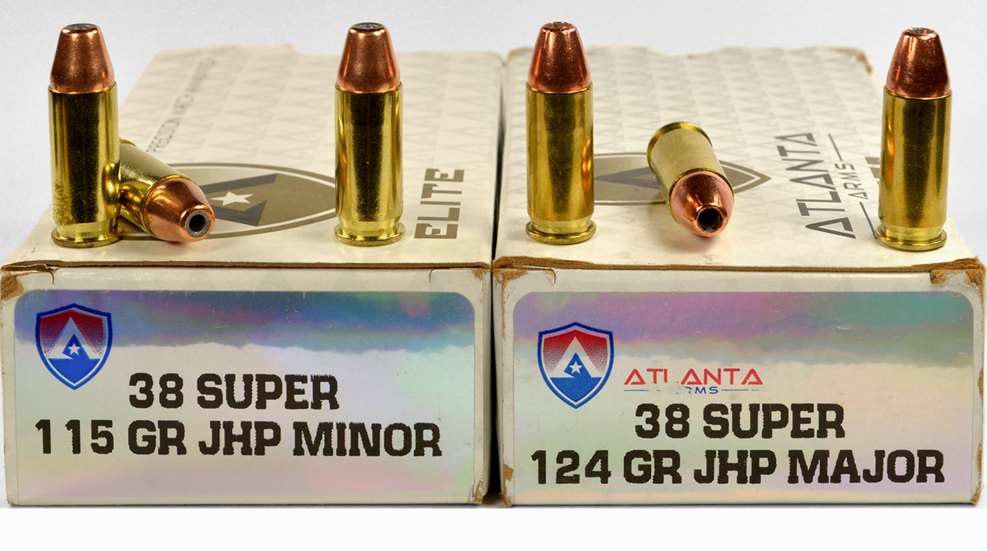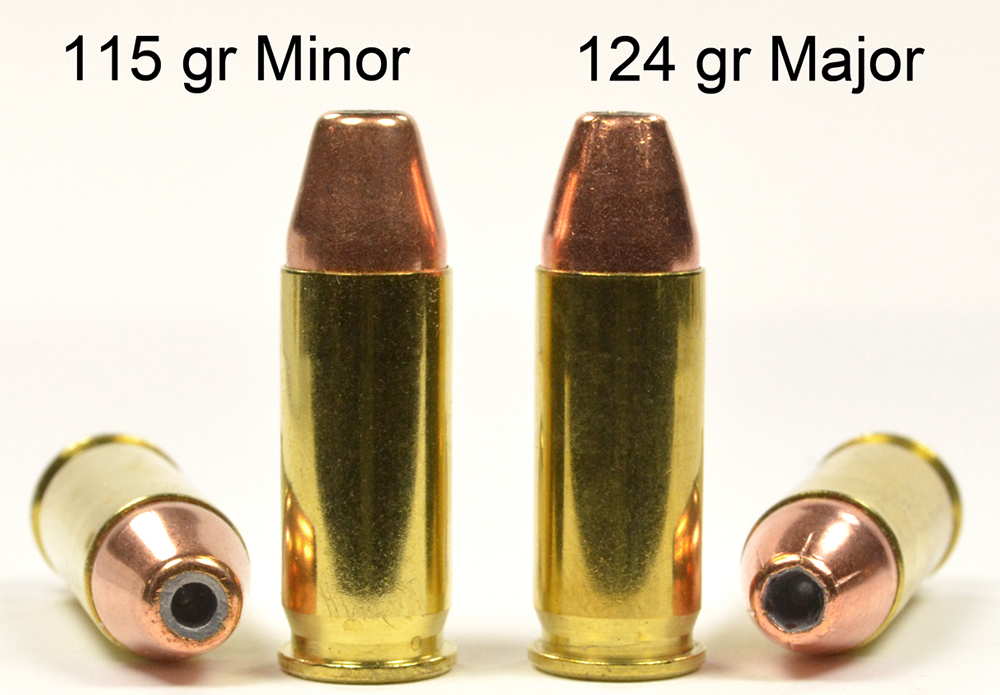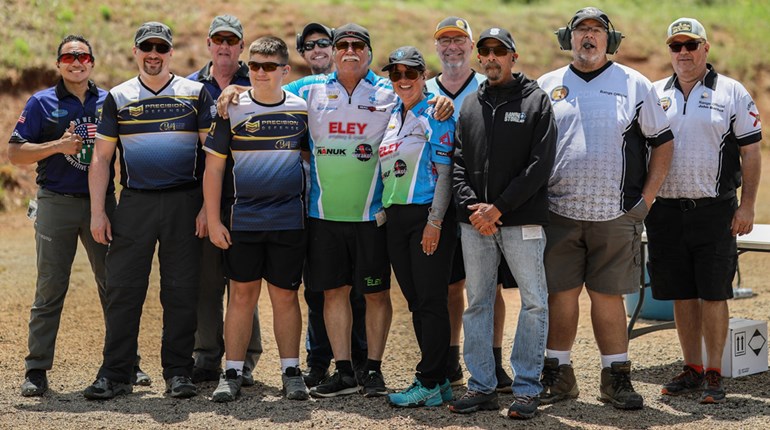
The common calibers used in practical pistol competitions are the 9mm Luger, .38 Super, .40 S&W and the .45 ACP. The .38 Super is usually thought of as used only in Open division in compensated pistols in IPSC/USPSA competitions. It has been the cartridge of choice in this division for many years because of its reliability and long overall length, which allows the use of large amounts of slow powders that are desired to provide gas to get the most from the recoil and muzzle rise dampening effects from a compensator.
The .38 Super is also popular in NRA Action Pistol, i.e. the Bianchi Cup, where it has brought home many victories, notably in the hands of Doug Koenig and Tiffany Piper.
Shooters also use the .38 Super in other USPSA divisions, especially Single Stack. The downside to using the .38 Super in anything other than Open Division is that due to how the rules are written, 9mm/.38-caliber pistols are not eligible for Major scoring (165 power factor) like they are in Open division, and are limited to Minor scoring (125 power factor). The exception to this is the Revolver division where 9mm/.38-caliber cartridges qualify for Major, and yes some revolvers have been chambered for .38 Super. Bianchi Cup rules have a 120 power factor minimum for all divisions.
Minor scoring in IPSC/USPSA means that you don’t get as many points if your hit is outside the A zone as you would if you were shooting Major power factor. In spite of this restriction, some shooters opt for the .38 Super anyway. The cartridge, loaded to Minor power factor, has less recoil than Major ammunition, which allows for faster follow-up shots. And in the Single Stack division, you are allowed two more rounds in your magazine than Major calibers. When all your hits are in the A-zone, there is no disadvantage for Minor scoring. Most of you can do this, right?
Most competitors load their own ammunition, but not everyone does. Plenty of factory .38 Super ammunition makes Minor power factor. A few factory .38 Super loads will make Major power factor, but many of these are designed for self-defense and are rather expensive.
Fortunately, Atlanta Arms makes two loads with the competitive .38 Super shooter in mind. They offer a load for Minor that drives a 115-grain JHP bullet to 1120 fps (128 power factor) and a load for Major that drives a 125-grain JHP bullet to 1380 fps (172 power factor). These loads were originally designed for the U.S. Army Marksmanship Unit Action Pistol Team, so you know they’re designed for accuracy. Tiffany Piper used Atlanta Arms’ Minor load for her 2016 Bianchi Cup Championship win. What better endorsement could you ask for?
Atlanta Arms offers this load in two different kinds of cases: traditional semi-rimmed cases and rimless .38 Super Comp cases. Some shooters have found that the rimless cases feed more reliably from their double stack magazines, a common feature of many raceguns. I tested the semi-rimmed versions.
The Major ammo I received was loaded with 124-grain bullets, not a 125-grain bullet as indicated at their website. The box was appropriately marked 124-grain. No problem, 124- and 125-grain bullets are indistinguishable by weight.
I pulled two bullets from each load and weighed the powder and bullets. The powder charge weight for the Major load was an average of 8.0 grains. This is about an average weight of powder that would be used for this bullet weight in the .38 Super for this velocity. Some powders would use more weight for this velocity, and others would require less weight. The bullets weighed 123.9 grains. The powder weight for the Minor load was 5.0 grains, and the bullets weighed 114.8 grains. Both rounds were loaded to an overall length in the 1.235-inch to 1.240-inch range.
I test fired this ammunition in a Colt .38 Super 80 Series Government Model (5-inch barrel). This gun has not been accurized and still sports the factory barrel, so it does not qualify as a match-grade pistol, but I thought I’d see how it liked the Atlanta Arms ammunition.
The gun was fired in a Ransom Rest. Three 10-shot groups were fired with each load at 25 yards. Velocity was recorded with a Shooting Chrony chronograph at about 10 feet.
Both loads achieved their intended power factor in my 5-inch barrel with some to spare. The 115-grain load clocked at 1163 fps for a power factor of 134. The 124-grain load clocked at an impressive 1447 fps for a power factor of 179. It’s better to clock a little faster than a little slower. You want to make sure your load makes the desired power factor.
Accuracy was good with both loads. The 115-grain Minor load produced an average 10-shot group size of 2.6-inches. That’s not bad for a ‘loose’ factory pistol. The Colt liked the 124-grain Major load even more, producing an average 10-shot group of 2.1-inches. Imagine what a tight gun would do with this ammunition! Feeding, extraction and ejection were flawless.
Major power ammunition, by necessity, is loaded to high pressure. The pressure varies and the safe use of this ammunition in a firearm depends on the selection of components and the gun’s design. Most competitive pistols use a barrel designed to fully support the case to reduce the chance of excess case bulge or blowout due to high pressure.
My Colt’s barrel leaves a portion of the case head unsupported by the chamber at the feed ramp. Some ammunition will produce excessive bulging in this region if the pressure is too high or the brass is not strong enough. I examined the brass of the Major loading for case bulge in this unsupported region. Of 30 rounds fired, 22 cases had a slight bulge in the unsupported region of the chamber. These rounds were loaded in Starline’s standard .38 Super cases, not their heavy duty +P cases. The bulge was very small but visible, though I did not consider it to pose an imminent danger. Still, based on the bulge, I would recommend that this ammunition be used only in barrels that offer full case support.
Priced at $21 for 50 rounds, they are a bargain. That’s less than you’ll pay for many brands of FMJ ammo that won’t shoot nearly as accurately. This is quality ammunition that makes the intended power factor and shoots straight. The Minor ammunition is ideal when you want light recoil, and the Major ammunition is ideal when you want the full power that the fabulous .38 Super provides. Additionally, Atlanta Arms loads other premium rounds for handguns and rifles. Check them out at: atlantaarms.com.
All figures by the author.


































